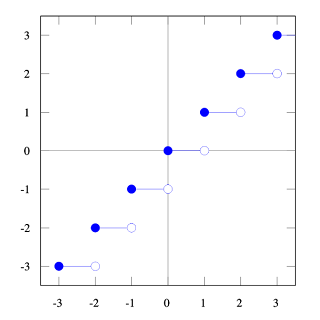After reading Cindy’s contribution last month concerning birthdays, my mathematical mind took off on its own musings about numbers and age.

People use numbers to represent age in a way that is not only different from the way we are taught to round numbers, but also conflicts with the linear relationship age has with time. When else would someone round 23.95 to 23 instead of to 24? *
Contrary to the way we were taught to round numbers, we all represent age by rounding down to the last year. Now, I’d be the first to admit that it would be impractical, not to mention irritating, to hear a grown person saying, “I’m 32 and a half.” Think about it: in just one day, your 40th birthday, you go from rounding down to 39 to rounding down to 40. Really you just aged one more day, or several more minutes.
Time is continuous, but we treat age as though it is discrete. If you graphed age as a function of time, it would not be a straight line, but instead a floor function. And birthdays are the points of discontinuity, (points where the graph is not connected). In English, we say “I am 25,” to mean “I have lived 25 years so far.” Other languages, such as Spanish and French, approach age slightly differently by phrasing it, “J’ai 40 ans,” (which translates from French to English as “I have 40 years”). “Having 40 years” really means you have lived for 40 years, but you’re experiencing your 41st year of your life! "Being 25" means you're in your 26th year.
In English, we say “I am 25,” to mean “I have lived 25 years so far.” Other languages, such as Spanish and French, approach age slightly differently by phrasing it, “J’ai 40 ans,” (which translates from French to English as “I have 40 years”). “Having 40 years” really means you have lived for 40 years, but you’re experiencing your 41st year of your life! "Being 25" means you're in your 26th year.
This is different from the way we approach years as a function of time. When we say the year 2010, we indicate that it is the 2010th year since we started counting. When we say it’s June 4th, we indicate that it’s the fourth day in the month of June. However, if I were to say I’m 11, I’m really living the 12th year of my life.
Of course I understand the motivations behind common age-naming practices. You could call it vanity. You could call it fear of aging. We want our age to be represented by the smallest number possible, and for practical purposes, we need it to be a cardinal number. But if we’re already rounding down to the nearest year, why not take it further? Why not round down to the nearest 5 years? Try it! If anyone accuses you of lying, tell them you just round differently.

This piece was written for my brother Matthew, who this week switches from rounding down to 29 to rounding down to 30. Don’t worry. I’ll remind him that he’s really living his 31st year!
*I would love more examples of instances when we do round down like this. Please use the comment section to share them.



噴泉的高度,不會超過它的源頭。一個人的事業也是如此,它的成就絕不會超過自己的信念。..................................................